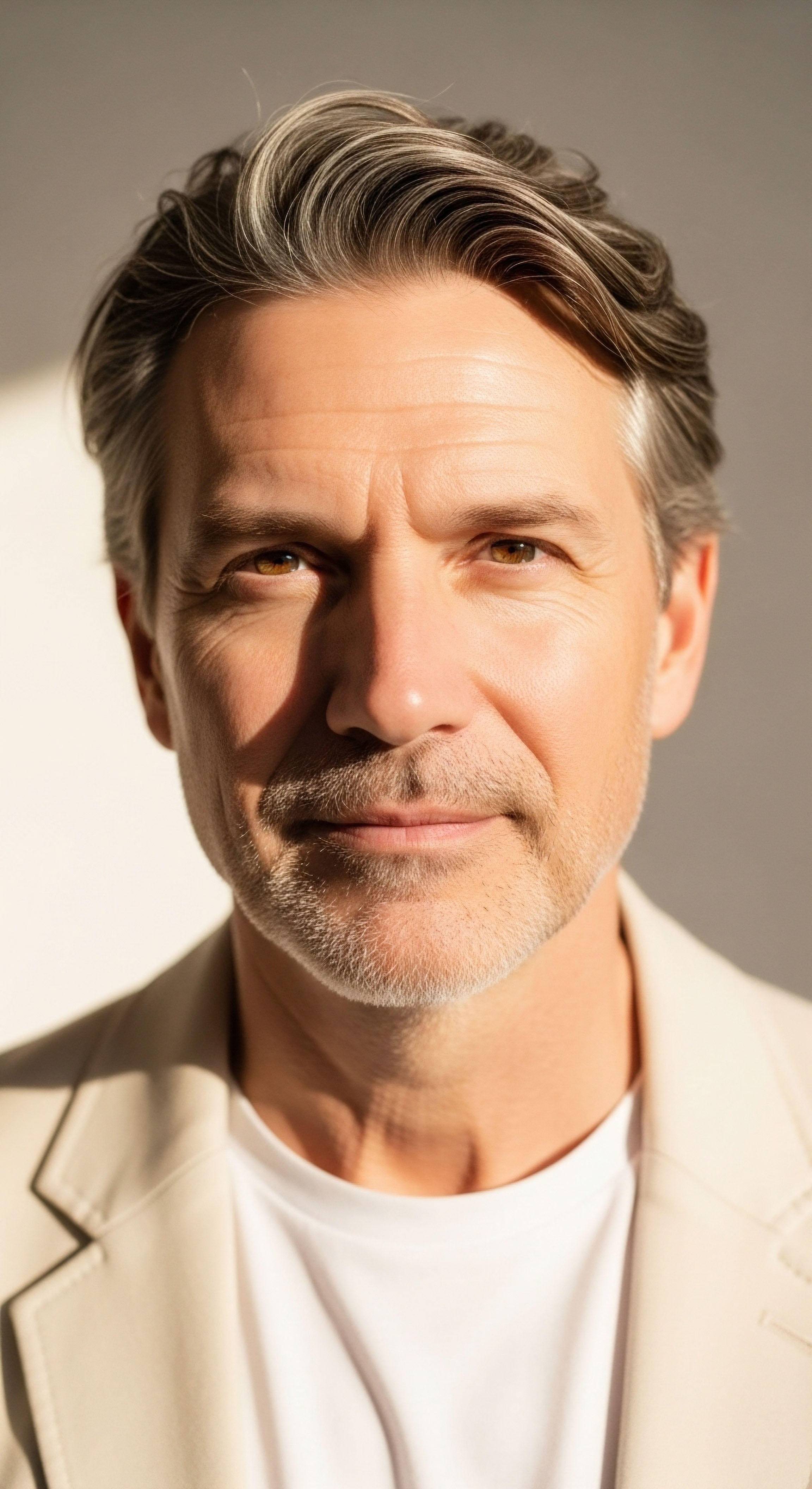

Fundamentals
Beginning a protocol of testosterone replacement therapy (TRT) marks a significant decision in your personal health timeline. You have likely arrived here after a period of experiencing symptoms that diminish your sense of vitality ∞ fatigue, mental fog, a loss of drive ∞ and have sought a clinical solution.
The initiation of therapy is a foundational step. It provides your system with the raw material it has been lacking. The ideal lifestyle on this path involves creating a physiological environment where this new input can be used with maximum efficiency and benefit. Your body is a deeply interconnected system of systems, and hormonal optimization is a process of recalibrating that entire network.
To understand what makes a lifestyle “ideal” in this context, we must first look at the body’s own internal communication network, the Hypothalamic-Pituitary-Gonadal (HPG) axis. Think of this as a sophisticated thermostat system. The hypothalamus in your brain senses when testosterone levels are low and sends a signal, Gonadotropin-Releasing Hormone (GnRH), to the pituitary gland.
The pituitary, in turn, releases Luteinizing Hormone (LH) and Follicle-Stimulating Hormone (FSH). LH is the specific messenger that travels to the testicles, instructing them to produce testosterone. When you introduce testosterone from an external source, the hypothalamus senses that levels are now sufficient.
It then dials down its own signals to the pituitary, which in turn stops sending LH to the testicles. This is a normal and expected feedback loop. The “ideal lifestyle” therefore, is one that supports every other metabolic process in your body so this new, stable level of testosterone can perform its vast array of jobs without interference.
The commencement of hormonal therapy is the start of a biological partnership, where lifestyle choices determine the ultimate success of the intervention.

The Four Pillars of a Supportive Lifestyle
Your daily habits are powerful inputs into your endocrine system. They can either create a state of harmony or a state of static that interferes with hormonal signaling. On TRT, the goal is to build a foundation that enhances the therapy’s effectiveness, mitigates potential side effects, and promotes a state of holistic well-being. This foundation rests on four core pillars.
- Nourishment Architecture. This refers to building a diet based on nutrient-dense, whole foods. The foods you consume provide the essential building blocks for cellular function, neurotransmitter production, and inflammation management. A proper nutritional strategy directly influences how your body utilizes testosterone.
- Purposeful Movement. Physical activity does much more than burn calories. Specific types of exercise can increase the sensitivity of your body’s androgen receptors, which are the cellular “docks” where testosterone binds to do its work. More sensitive receptors mean you get a more powerful effect from the same amount of hormone.
- Sleep and Circadian Calibration. Sleep is a critical period for metabolic and cognitive restoration. It is when your body clears cellular debris, consolidates memory, and regulates the stress hormones that can interfere with testosterone’s beneficial effects. Aligning your sleep schedule with your natural circadian rhythm is a potent tool for systemic health.
- Stress and Nervous System Modulation. Chronic stress places the body in a persistent state of “fight or flight,” characterized by high levels of the hormone cortisol. Elevated cortisol can promote fat storage, induce insulin resistance, and create a physiological environment that works directly against the goals of hormonal optimization. Learning to modulate your stress response is essential.
These four pillars are not a checklist of tasks to be completed. They are an integrated system. Improvements in one area will naturally support the others, creating a positive feedback loop that enhances your body’s ability to thrive. The journey of TRT is a proactive one. It is an opportunity to become a conscious participant in your own biology, using these lifestyle principles to guide your system back to a state of optimal function and renewed vitality.


Intermediate
As you become accustomed to the baseline stability that TRT provides, the next phase of your journey involves a more detailed and mechanistic approach to lifestyle integration. This means understanding precisely how your choices influence the complex biochemistry that underpins your hormonal health.
The goal is to move from broad principles to specific, targeted actions that optimize your protocol, manage potential metabolic shifts, and ensure you are deriving the maximum benefit from your therapy. This requires a deeper look at nutrition, a more nuanced application of exercise, and a clear understanding of the ancillary medications that are often part of a comprehensive protocol.

Architecting Your Metabolic Environment through Nutrition
The food you consume directly modulates several key variables in the TRT equation, including Sex Hormone-Binding Globulin (SHBG), insulin sensitivity, and systemic inflammation. SHBG is a protein that binds to testosterone in the bloodstream, rendering it inactive. While some SHBG is necessary, excessively high levels can limit the amount of “free” testosterone available to your cells.
High insulin levels, often a result of diets rich in processed carbohydrates and sugars, are known to suppress SHBG, which might sound beneficial. A state of chronic high insulin, known as insulin resistance, promotes inflammation and fat storage, both of which can increase the activity of the aromatase enzyme.

Macronutrient and Micronutrient Strategy
A well-formulated nutritional plan for a man on TRT prioritizes protein, healthy fats, and complex carbohydrates from whole-food sources. This composition helps regulate blood sugar, provides the building blocks for muscle and hormones, and supplies essential micronutrients.
- Protein. Adequate protein intake is vital for supporting the increased muscle protein synthesis stimulated by testosterone. Aiming for a consistent intake distributed throughout the day helps maintain lean body mass, which in turn improves metabolic rate and insulin sensitivity.
- Fats. Healthy dietary fats, particularly monounsaturated and omega-3 fatty acids, are precursors for steroid hormone production and play a role in managing inflammation. Sources like avocados, olive oil, nuts, and fatty fish are integral components of a supportive diet.
- Micronutrients. Certain vitamins and minerals are cofactors in testosterone-related pathways. Zinc is directly involved in testosterone production, while magnesium can help modulate SHBG. Vitamin D functions as a steroid hormone itself and is essential for overall endocrine health.
| Nutrient/Food Group | Primary Biological Impact on TRT | Examples |
|---|---|---|
| Lean Protein | Supports muscle protein synthesis; promotes satiety and stable blood sugar. | Chicken breast, lean beef, fish, eggs, legumes. |
| Healthy Fats | Provides precursors for hormone synthesis; reduces inflammation. | Avocado, olive oil, almonds, walnuts, fatty fish (salmon). |
| Fibrous Vegetables | Improves insulin sensitivity; supports gut health and estrogen metabolism. | Broccoli, spinach, kale, cauliflower, bell peppers. |
| Zinc-Rich Foods | Acts as a crucial cofactor in testosterone synthesis. | Oysters, beef, pumpkin seeds, lentils. |
| Magnesium Sources | May help lower SHBG, increasing free testosterone availability. | Spinach, almonds, dark chocolate, black beans. |

Exercise Programming for Androgen Receptor Sensitivity
While any physical activity is beneficial, a strategic combination of resistance training and cardiovascular exercise provides synergistic effects for a man on TRT. The primary goal of exercise in this context extends beyond aesthetics; it is about enhancing cellular signaling.
Strategic exercise enhances the body’s receptivity to testosterone at a cellular level, making the therapy more potent.

Resistance and Cardiovascular Training Roles
Resistance training, particularly involving large muscle groups through compound movements like squats, deadlifts, and presses, has been shown to increase the density and sensitivity of androgen receptors in muscle tissue. This means your body becomes more efficient at using the testosterone circulating in your system.
Cardiovascular exercise is crucial for managing a key side effect of TRT ∞ increased hematocrit (red blood cell concentration). Regular aerobic activity improves blood flow, supports cardiovascular health, and can help keep hematocrit within a safe range.

Understanding Ancillary Protocols Anastrozole and Gonadorelin
A comprehensive TRT protocol often includes medications designed to manage the downstream effects of the therapy. Two of the most common are Anastrozole and Gonadorelin. Understanding their purpose is key to appreciating the holistic nature of modern hormonal optimization.
Anastrozole is an aromatase inhibitor. The aromatase enzyme converts a portion of testosterone into estradiol, a potent form of estrogen. While men require a certain amount of estradiol for bone health, cognitive function, and libido, excessive levels can lead to side effects like water retention, gynecomastia (breast tissue development), and mood volatility.
Anastrozole works by inhibiting this enzyme, thereby controlling the conversion rate and helping to maintain an optimal testosterone-to-estradiol ratio. Dosing is highly individualized and guided by both symptoms and lab results, with a typical starting point being a low dose taken once or twice a week.
Gonadorelin is a synthetic version of Gonadotropin-Releasing Hormone (GnRH). As discussed in the fundamentals, exogenous testosterone suppresses the body’s natural GnRH signal from the hypothalamus. This leads to a shutdown of LH production and subsequent testicular atrophy and cessation of endogenous testosterone and sperm production.
Gonadorelin is used to periodically stimulate the pituitary gland to release its own LH and FSH. This action helps to maintain testicular size and function, preserving a degree of the body’s natural hormonal machinery and maintaining fertility options. It is typically administered via small, subcutaneous injections, often on a daily or every-other-day schedule to mimic the body’s natural pulsatile release of GnRH.
| Medication | Mechanism of Action | Primary Goal in TRT Protocol | Typical Administration |
|---|---|---|---|
| Anastrozole | Inhibits the aromatase enzyme, reducing the conversion of testosterone to estradiol. | Manage high estradiol symptoms; maintain optimal T:E2 ratio. | Oral tablet, 0.5 mg 1-2 times per week (dose is adjusted based on labs). |
| Gonadorelin | Stimulates the pituitary gland to release LH and FSH. | Maintain testicular size and function; preserve fertility. | Subcutaneous injection, often nightly or multiple times per week. |
By integrating these specific lifestyle and medical strategies, you transition from passively receiving therapy to actively managing your endocrine system. This intermediate level of understanding allows for a collaborative process with your healthcare provider, using subjective feedback and objective lab data to fine-tune a protocol that is uniquely yours.


Academic
An academic exploration of the ideal lifestyle for a man undergoing testosterone therapy moves beyond programmatic advice and into the realm of systems biology. At this level, we examine the intricate molecular and physiological mechanisms that connect hormonal inputs with cellular responses, cognitive function, and long-term metabolic health.
The central thesis is that an optimized lifestyle creates a state of high androgen receptor sensitivity and low systemic inflammation, thereby maximizing the genomic and non-genomic effects of testosterone. This discussion will focus on the neuroendocrine effects of testosterone and the ways in which lifestyle factors modulate its action at the cellular level, particularly within the central nervous system.

Neurosteroid Action and Cognitive Function
Testosterone exerts its influence on the brain through multiple pathways. It can act directly on androgen receptors, which are widely distributed throughout the brain, including in the hippocampus, amygdala, and cerebral cortex. It also serves as a prohormone, being converted locally within glial cells and neurons into dihydrotestosterone (DHT) via the 5-alpha reductase enzyme, or into estradiol (E2) via the aromatase enzyme.
Both DHT and E2 have their own potent effects on neuronal function. This local conversion means that the brain can fine-tune its own steroidal environment. The cognitive and mood-related benefits of TRT are a direct result of these actions.
Systematic reviews and meta-analyses have investigated the relationship between testosterone supplementation and cognition. While results can be heterogeneous, a body of evidence suggests improvements in specific domains, particularly for hypogonadal men. One meta-analysis pointed to significant improvements in executive function and memory.
Another review noted that testosterone appears to activate a distributed cortical network during spatial cognition tasks. The subjective experience of improved mental clarity, focus, and motivation reported by many men on TRT is likely a manifestation of testosterone’s role in modulating key neurotransmitter systems, including dopamine, serotonin, and GABA. Its actions in the limbic system, particularly the amygdala, also contribute to the regulation of mood and the mitigation of anxiety and irritability associated with low testosterone states.

How Does Lifestyle Modulate Neuroendocrine Effects?
The efficacy of these neuroendocrine actions is not solely dependent on the serum concentration of testosterone. It is profoundly influenced by the cellular environment, which is shaped by lifestyle. For instance, chronic systemic inflammation, driven by a poor diet or inadequate sleep, can impair the function of the blood-brain barrier and promote neuroinflammation.
This state can blunt the sensitivity of androgen receptors and interfere with the delicate balance of local steroidogenesis in the brain. Conversely, a lifestyle that promotes low inflammation, such as one rich in omega-3 fatty acids and polyphenols, creates a more favorable environment for testosterone’s neuroprotective and cognition-enhancing effects.

The Central Role of Insulin Sensitivity and SHBG
From a systems biology perspective, perhaps no single factor is more influential on the efficacy of TRT than insulin sensitivity. The relationship between insulin, SHBG, and free testosterone is a critical control point in androgen biology. Hyperinsulinemia, a consequence of insulin resistance, directly suppresses the liver’s production of SHBG.
While this may initially seem to increase free testosterone, the underlying state of insulin resistance is globally detrimental. It promotes visceral adiposity, which is a primary site of aromatase activity, leading to increased conversion of testosterone to estradiol. This can disrupt the optimal T:E2 ratio, potentially leading to unwanted side effects and diminishing the net androgenic signal.
An optimized lifestyle, centered on maintaining low fasting insulin levels through nutrition and exercise, directly addresses this. A diet low in refined carbohydrates and high in fiber and protein helps prevent large insulin spikes. Resistance training and high-intensity interval training are particularly effective at improving insulin sensitivity in skeletal muscle, increasing glucose uptake independent of insulin.
By improving insulin sensitivity, one can achieve a healthier SHBG level, reduce aromatase activity, and decrease systemic inflammation, creating a physiological state in which administered testosterone can function optimally.
Optimizing insulin sensitivity is a master lever for controlling SHBG, reducing aromatase activity, and enhancing the overall efficacy of hormonal therapy.

What Is the Long Term Clinical Significance?
The long-term clinical significance of adopting this integrated lifestyle approach is substantial. It reframes TRT as one component of a broader strategy for promoting metabolic health and longevity. Research has shown that lifestyle interventions alone can significantly improve health outcomes, and when combined with TRT, the potential for synergistic effects is considerable.
For example, while one study found that adding testosterone to a lifestyle intervention in older, obese men did not further improve overall physical function, it did attenuate the loss of muscle mass and hip bone mineral density during weight loss. This highlights the protective effects of testosterone within a metabolically supportive context.
Ultimately, the academic view of the ideal TRT lifestyle is one of precision and personalization. It involves using objective data from comprehensive lab panels (Total T, Free T, E2, SHBG, hs-CRP, HOMA-IR) to guide lifestyle interventions.
It recognizes that the goal is to create a systemic environment that allows for the full expression of testosterone’s beneficial effects, from the synapse in the brain to the androgen receptor in the muscle cell. This approach ensures that the therapy is not merely replacing a number but is restoring a complex and vital signaling system within the body.

References
- Bhasin, Shalender, et al. “Testosterone Therapy in Men With Hypogonadism ∞ An Endocrine Society Clinical Practice Guideline.” The Journal of Clinical Endocrinology & Metabolism, vol. 103, no. 5, 2018, pp. 1715 ∞ 1744.
- Fui, Mark Ng, et al. “Testosterone Replacement Therapy Added to Intensive Lifestyle Intervention in Older Men With Obesity and Hypogonadism.” The Journal of Clinical Endocrinology & Metabolism, vol. 106, no. 5, 2021, pp. 1432-1444.
- Hull, James. “Testosterone and the Brain.” AUA News, American Urological Association, Feb. 2021.
- Janjgava, Shota, et al. “Testosterone Supplementation and Cognitive Functioning in Men-A Systematic Review and Meta-Analysis.” Journal of the Endocrine Society, vol. 3, no. 8, 2019, pp. 1465-1484.
- Punjani, Naeem, et al. “The Utilization and Impact of Aromatase Inhibitor Therapy in Men With Elevated Estradiol Levels on Testosterone Therapy.” Sexual Medicine, vol. 9, no. 4, 2021, p. 100378.
- “Human Chorionic Gonadotropin (HCG) Replacements For Men On Testosterone Therapy.” Aspire Rejuvenation Clinic, 2023.
- “Anastrozole (Arimidex) for Men on Testosterone Therapy.” Vantage Health LLC, 2018.
- “Exploring Low-T Treatment Options ∞ From Lifestyle Changes to Medical Interventions.” Ironwood Urology, 2023.

Reflection
You have now explored the foundational, intermediate, and academic dimensions of integrating lifestyle with testosterone therapy. This knowledge provides a map, showing the connections between your daily actions and your internal biological landscape. It illuminates the pathways through which nutrition, movement, and recovery become powerful tools for amplifying the benefits of your clinical protocol. The information presented here is a starting point. It is the beginning of a conversation with your own body, a system of profound complexity and intelligence.
The true application of this knowledge begins with self-awareness. It invites you to observe how your body responds to different inputs. How does a particular meal affect your energy and mental clarity? How does a consistent sleep schedule alter your mood and resilience?
This journey is one of personal science, where you are both the researcher and the subject. The data you gather, from your subjective feelings to your objective lab markers, becomes the feedback that guides your next steps.
The ultimate goal is to cultivate a deep, intuitive understanding of your own physiology, allowing you to make choices that consistently move you toward a state of greater vitality and function. This path is yours to walk, and the power to shape its outcome resides within the choices you make each day.

Glossary

testosterone replacement therapy

androgen receptors

insulin resistance

sex hormone-binding globulin

systemic inflammation

aromatase enzyme

shbg

insulin sensitivity

anastrozole

gonadorelin

aromatase inhibitor

testosterone therapy

metabolic health

androgen receptor sensitivity

free testosterone




